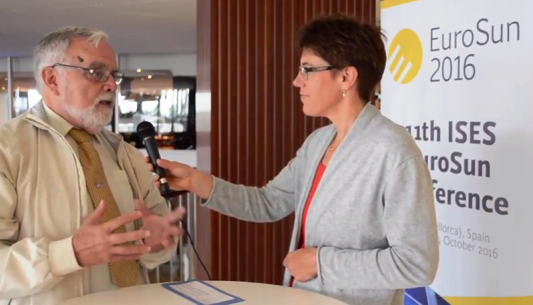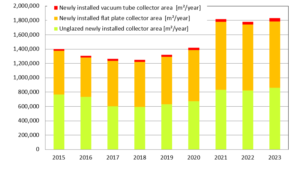

Solar Process Heat in Chile: “It is essential to use the ESCO model”
 The world’s largest process heat installation has recently completed its third year of operation. The 39,000 m² collector field, which went online in October 2013 at Codelco´s Gabriela Mistral mine, is located 100 kilometres south of the town of Calama in Chile´s high central desert. Planning, delivery and installation of the solar field were done by Chilean-Danish joint-venture Pampa Elvira Solar, which has since been the operator of the system as well. The plant provides around 80 % of the energy required for the last step in copper production, the electrolytic refining of the metal in an acid bath. Solarthermalworld.org spoke with Roberto Roman, Associate Professor at the Faculty of Physics and Mathematical Sciences of the University of Chile. Roman has been part of a university team advising Codelco, Chile´s state-owned mining company, on solar mining from the very beginning.
The world’s largest process heat installation has recently completed its third year of operation. The 39,000 m² collector field, which went online in October 2013 at Codelco´s Gabriela Mistral mine, is located 100 kilometres south of the town of Calama in Chile´s high central desert. Planning, delivery and installation of the solar field were done by Chilean-Danish joint-venture Pampa Elvira Solar, which has since been the operator of the system as well. The plant provides around 80 % of the energy required for the last step in copper production, the electrolytic refining of the metal in an acid bath. Solarthermalworld.org spoke with Roberto Roman, Associate Professor at the Faculty of Physics and Mathematical Sciences of the University of Chile. Roman has been part of a university team advising Codelco, Chile´s state-owned mining company, on solar mining from the very beginning.Photo: Taken from the video interview at the Eurosun 2016
Solarthermalworld.org: Chile is said to be a prospering renewable market. What are the major drivers for growth?
Roman: With more than 2,600 kWh/m²a, northern Chile offers the best solar resources in the world. We must transition from fossil fuels to renewables, and this has been understood in Chile after many, many years of work. Solar power capacity has already added up to more than 1,000 MW and the figure is growing quite quickly. The ones we call the non-conventional renewables – wind, solar, biomass and hydro systems below 40 MW – have already exceeded 12 % of energy generation; in 2006, their share was below 5 %.
Solarthermalworld.org: What experiences have you made with dust and decreasing efficiency in this desert area? How and how often are collectors cleaned?
Roman: Dust soiling is a nagging and complex problem. Large PV and collector systems in northern Chile are usually cleaned every month, with a cleaning schedule depending on the build-up of soil on different parts of the solar plant. The amount varies widely from location to location, and certain other factors may impact soiling as well. One of the most important things is to minimise disturbances during construction on site and stabilise unpaved roads.
Solarthermalworld.org: Chile has some of the best direct natural irradiation resources worldwide. Can concentrating collectors do a better job of delivering temperatures at above 95 °C to mining projects than flat plate ones?
Roman: In my opinion, concentrating technologies possess inherent advantages which make them especially suitable for providing thermal energy between 95 and around 200°C. First, they only make use of mirrors and the fluid loop can be very simple. A flat plate collector has tempered glass, a selective absorber plate, casing, insulation and other components, which increase its weight per square meter and ultimately make it more expensive.
Second, tracking raises the yield in comparison to a flat plate system. And more important, one can easily de-focus the field to avoid stagnation temperatures.
To make solar thermal truly competitive, you need to provide heat between 40 and not more than 60 USD/MWhth. Look at large-scale CSP projects: Their operators expect to supply electrical energy at around 90 USD/MWh. When you take the 30 % efficiency for electricity production into account, CSP systems focused on heat production have already been generating thermal energy for less than 30 USD/MWh. And with a heat-only system, you avoid both power and condensing blocks. So basically, the problem is identifying the proper markets and scaling up production to meet those targets.
Solarthermalworld.org: Mining contributes almost 20 % to Chile’s GDP. Do you know of any other mine managers who intend to follow the example of the Gabriela Mistral mine?
Roman: There are other mine managers interested in the technology, but they are hesitating, as the price of copper is going down. The copper industry is not as eager to invest as it used to be. Although any funds would come from the parent company, the managers in charge of the mines don’t want to sign long-term contracts.
Solarthermalworld.org: The Gabriela Mistral mine project is operated by an Energy Service Company. Do you think that offering solar heat contracts makes it easier for mining companies to warm to solar?
Roman: From the beginning of the tender process, we have emphasised that it was essential to use the ESCO model, as the company in charge of the operation had a first-rate interest in attaining optimum performance. There are many reasons for this. One of them is that mine operators tend to prioritise projects with a payback period of no more than 5 or 6 years (for example, because of the volatility of the markets) and renewables typically show longer packback periods. Another is that their maintenance efforts are focused on core business activities, so if upkeep of the renewable systems is done by the same team that maintains the mining operation, solar system performance will take a backseat.
This interview was conducted by Bärbel Epp.


